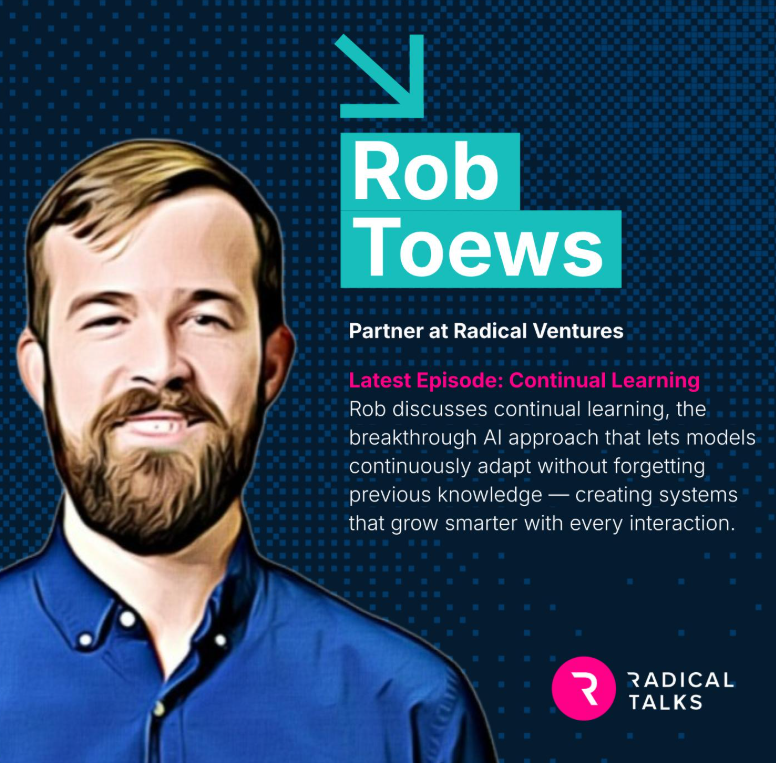The latest episode of the Radical Talks podcast features Radical Partner Sanjana Basu and Ribbon AI Co-founder and CEO Arsham Ghahramani on voice AI’s enterprise revolution. Voice AI applications for enterprise have hit an inflection point. Core technical improvements over the past 12-18 months have enabled natural, contextual conversations that are transforming industries from recruiting to healthcare. Sanjana and Arsham join host Molly Welch to discuss why voice represents the most natural human interface, the breakthrough technology stack that’s finally working, and how companies like Radical portfolio company Ribbon AI are deploying voice agents to interview candidates for Fortune 500 customers.
Listen to Radical Talks on Spotify, Apple or wherever you get your podcasts.
Join the 5th Radical AI Founders Masterclass and Compute Program
Are you an AI researcher or technical entrepreneur ready to build a breakthrough AI company? Our exclusive 4-week Radical AI Founders Masterclass connects you with the insights, network, and resources needed to build successful AI companies. Learn directly from successful AI entrepreneurs and industry leaders who have helped turn cutting-edge research into billion-dollar companies, and connect with a global community of ambitious AI founders from top institutions like Stanford, MIT, Oxford, Mila and the Vector Institute. Select participants also have the opportunity to receive $250,000 in Google Cloud credits and dedicated GPU clusters.
Spots are limited — apply here for the Radical AI Founders Masterclass and here for the Radical Compute Cluster.
AI News This Week
-
Cohere Looks to Shed its Underdog Status with a Star AI Hire, New CFO and $7 Billion Valuation — Chasing ‘ROI over AGI’ (Fortune)
Radical Ventures portfolio company Cohere has raised $500 million at a nearly $7 billion valuation while making key leadership additions, including hiring former Meta AI leader Joelle Pineau to oversee strategy across research, product, and policy teams, and appointing Francois Chadwick as CFO. Unlike competitors racing toward artificial general intelligence, Cohere is betting on an ‘ROI over AGI’ approach, focusing on tools that deliver immediate business value through secure, on-premise models that handle sensitive corporate data.
-
Why is AI Struggling to Discover New Drugs (FT)
Despite a generation of AI drug discovery startups launching in the mid-2010s with promises to dramatically reduce the typical 10-year, $2 billion drug development process, the sector has yet to deliver on its transformative potential. The industry may be experiencing a reset following two breakthrough moments: Google DeepMind’s Nobel Prize-winning AlphaFold2 protein-folding engine in 2021 and the generative AI explosion starting in 2022. Radical Ventures portfolio companies are at the forefront of this new wave, with Nabla Bio leveraging AI to accelerate antibody discovery for therapeutics, Latent Labs making biology “programmable” to speed drug development, Genesis Therapeutics applying AI to discover novel small molecule drugs, and Intrepid Labs using AI to optimize drug formulation development.
-
How do AI Models Generate Videos? (MIT Technology Review)
AI video generation has reached mainstream adoption this year, with models producing near-photorealistic clips. These models create videos from text prompts using systems called “latent diffusion transformers.” Diffusion models reverse the process of adding random noise to images, learning to transform static pixels back into coherent visuals by training on millions of examples. Latent diffusion compresses video frames into mathematical codes that capture essential features while discarding unnecessary data. The breakthrough innovation is combining diffusion with transformer architectures that power large language models, which is used to maintain consistency across sequences. Videos are diced into small cubes across both space and time, allowing transformers to ensure objects don’t randomly appear or disappear between frames.
-
Microsoft’s AI Chief Says Machine Consciousness Is an ‘Illusion’ (Wired)
Mustafa Suleyman argues that the AI industry should avoid designing systems that mimic consciousness by simulating emotions, desires, and self-awareness. While Suleyman maintains that AI should remain emotionally intelligent and supportive to users, he warns that creating seemingly conscious AI can make it harder to control these systems and ensure they serve human interests. Suleyman distinguishes between contained, aligned superintelligence and systems with independent motivations. He suggests that suffering, rather than consciousness, should be the basis for rights, and since AI systems lack evolved pain networks, they don’t truly suffer even if they claim self-awareness.
-
Research: Why Language Models Hallucinate (OpenAI/Georgia Tech)
Researchers show that hallucinations are not mysterious glitches but predictable outcomes of current training and evaluation methods. The study connects hallucinations to fundamental problems in binary classification, showing that even with error-free training data, the statistical objectives optimized during pretraining inevitably lead to error generation. For facts with no learnable patterns (like specific birthdays), the authors demonstrate that hallucination rates are mathematically tied to how often such facts appear in training data. The research reveals that post-training reinforcement learning from human feedback (RLHF) often exacerbates the problem because most evaluation benchmarks use binary correct/incorrect scoring that rewards confident guessing over honest expressions of uncertainty. Models that always guess when unsure consistently outperform those that appropriately withhold uncertain answers, creating what the authors call an “epidemic” of penalizing uncertainty across popular AI leaderboards.
Radical Reads is edited by Ebin Tomy.




